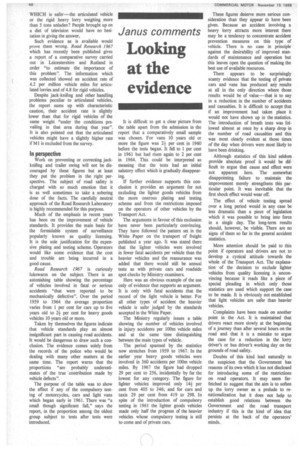Janus comments
Page 48

If you've noticed an error in this article please click here to report it so we can fix it.
Looking at the evidence
It is difficult to get a clear picture from the table apart from the admission in the report that a comparatively small sample was chosen. For vans 10 years old or more the figure was 2+ per cent in 1960 before the tests began. It fell to 1 per cent in 1961 but had risen again to 2 per cent in 1964. This could be interpreted as meaning that the tests had an initial salutory effect which is gradually disappearing.
If further evidence supports this conclusion it provides an argument for not excluding the lighter goods vehicles from the more onerous plating and testing scheme and from the restrictions imposed on the operators of other vehicles by the Transport Act.
The arguments in favour of this exclusion have never been particularly convincing. They have followed the pattern set in the White Paper on the transport of freight published a year ago. It was stated there that the lighter vehicles were involved in fewer fatal accidents per vehicle than the heavier vehicles and the reassurance was added that there would still be annual tests as with private cars and roadside spot checks by Ministry examiners.
Here was an obvious example of the use only of evidence that supports an argument. It is only with fatal accidents that the record of the light vehicle is better. For all other types of accident the heavier vehicle is safer judged by the standards accepted in the White Paper.
The Ministry regularly issues a table showing the number of vehicles involved in injury accidents per 100m vehicle miles and at the same time distinguishing between the main types of vehicle.
The period spanned by the statistics now stretches from 1959 to 1967. In the earlier year heavy goods vehicles were involved in 360 accidents per 100m vehicle miles. By 1967 the figure had dropped 29 per cent to 256, incidentally by far the lowest for any category. The figure for lighter vehicles improved only 14+ per cent from 405 to 346; and for cars and taxis 29 per cent from 419 to 298. In spite of the introduction of compulsory testing in 1961 the lighter goods vehicles made only half the progress of the heavier vehicles whose compulsory testing is still to come and of private cars. These figures deserve more serious consideration than they appear to have been given. Because an accident involving a heavy lorry attracts more interest there may be a tendency to concentrate accident prevention measures on this type of vehicle. There is no case in principle against the desirability of improved standards of maintenance and operation but this leaves open the question of making the best use of available resources_ There appears to be surprisingly scanty evidence that the testing of private cars and vans has produced any results at all in the only direction where those results would be of value—that is to say in a reduction in the number of accidents and casualties. It is difficult to accept that if an improvement had taken place it would not have shown up in the statistics. The introduction of breath tests was followed almost at once by a sharp drop in the number of road casualties and this was most clearly evident at those times of the day when drivers were most likely to have been drinking.
Although statistics of this kind seldom provide absolute proof it would be difficult to argue that cause and effect were not apparent here. The somewhat disappointing failure to maintain the improvement merely strengthens this particular point. It was inevitable that the first shock effect would wear off The effect of vehicle testing spread over a long period would in any case be less dramatic than a piece of legislation which it was possible to bring into force in a single day. The long-term results should, however, be visible. There are no signs of them so far in the general accident statistics.
More attention should be paid to this point if operators and drivers are not to develop a cynical attitude towards the whole of the Transport Act. The explanation of the decision to exclude lighter vehicles from quality licensing is unconvincing because it reads like a piece of special pleading in which only those statistics are used which support the case to be made. It is obviously not established that light vehicles are safer than heavier vehicles.
Complaints have been made on another point in the Act. It is maintained that drivers react more slowly at the beginning of a journey than after several hours on the road and that it is a mistake to argue the case for a reduction in the lorry driver's or bus driver's working day on the grounds of road safety.
Doubts of this kind lead naturally to the suspicion that the Government has reasons of its own which it has not disclosed for introducing some of the restrictions on road operators. It may seem farfetched to suggest that the aim is to soften up the lorry owner as a prelude to renationalization but it does not help to establish good relations between the Government and the road transport industry if this is the kind of idea that persists at the back of the operators' minds.




















































































































